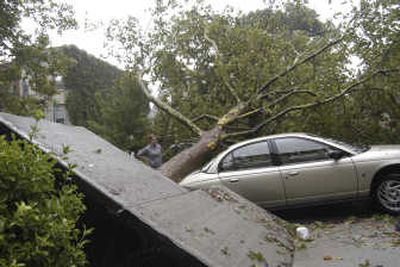Rain, flooding cripple New York City transit

NEW YORK – A torrential downpour sent water surging through New York’s subway system and highway tunnels and across airport runways Wednesday, leaving thousands of commuters stranded and one big question: How could 3 inches of rain bring the nation’s largest mass transit system to a halt?
The storm, which also spawned a rare tornado, hit just before dawn. By rush hour, the subway system was virtually paralyzed when pumping stations became overwhelmed. Bedlam resulted from too much rain, too fast; some suburban commuters spent a half day just getting to work.
“One big rain and it all falls apart,” said Ruby Russell, 64, as she sat waiting on a train in Brooklyn. She had been trying to get to Manhattan for three hours.
The failure renewed a debate about whether the network of pumps, sewers and drains that protects the city’s subways from flooding needs an overhaul. Every line experienced some sort of delay as track beds turned into streams gurgling with millions of gallons of rainwater. The washout was the third time in seven months that the subways were disrupted by rain.
Metropolitan Transit Authority engineers were asked to report back to Gov. Eliot Spitzer within 30 days with suggestions about how to deal with the chronic flooding.
The National Weather Service said a tropical air mass dumped an extraordinary amount of rain in a short period of time. The worst was recorded between 5 a.m. and 8 a.m., with 2.5 inches falling on Central Park and almost 3.5 on Kennedy International Airport.
Naturally, the storm water sought the low ground, and that meant the subways. Water poured in through vents, drowned the signal system and flooded the third rail, forcing a shutoff of power on some lines.
MTA Executive Director Elliot G. Sander said the intensity of the rain was simply overwhelming. The subway’s drainage system can generally handle a maximum of 1.5 inches of rainfall per hour.
“The timing and intensity of the storm took us by surprise,” Sander said.
In Manhattan, Times Square was one huge mess Wednesday, packed with many of the 4 million riders who rely on the subway system daily. Thousands waited for hours for any means of transportation, jostling one another to get on the few buses that arrived. The suburbs were no better: In Westchester County, hundreds of commuters were stopped on a Metro-North train because of track flooding.
The National Weather Service said a tornado touched down in Brooklyn, where winds downed trees, tore off rooftops and wrapped signs around posts. At least 40 homes were damaged.
Tornadoes have hit New York City before, but not often. The National Weather Service had records of at least five, plus sketchy detail on the last reported tornado sighting in Brooklyn, in 1889. None was as strong as Wednesday’s twister, which had winds as high as 135 mph.
A woman on Staten Island died when a car got stuck in an underpass and another car came along and hit hers, Mayor Michael Bloomberg said. A handful of people were injured.
At the end of the day, some trains were finally up and running. But commuters trying to get home were met with another unpleasant surprise: The storm left behind high humidity that felt like they were walking into a sauna – and when they got onto train cars, a sardine can.